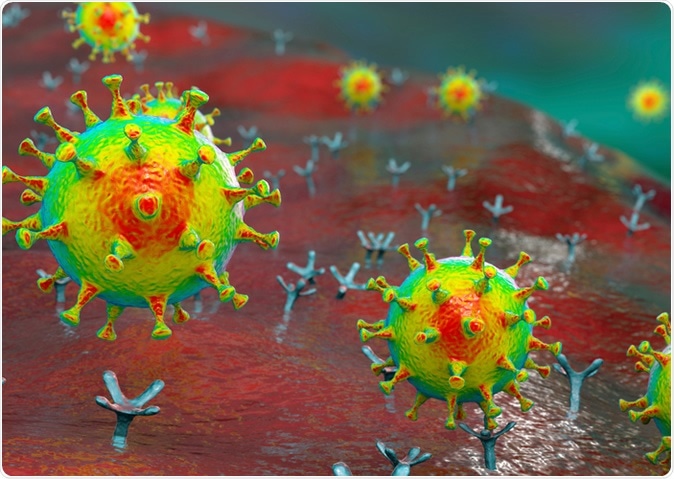TMPRSS2 is an endothelial cell surface protein that is involved in the viral entry and spread of coronaviruses including severe acute respiratory syndrome coronavirus 2 (SARS-CoV-2) – the virus that causes COVID19. Blocking TMPRSS2 could potentially be an effective clinical therapy for COVID-19.
.jpg)
Image Credit: Kateryna Kon/Shutterstock.com
What is TMPRSS2?
Transmembrane serine protease 2 (TMPRSS2) is a cell surface protein primarily expressed by endothelial cells across the respiratory and digestive tracts. As a serine protease, it is involved in the cleaving peptide bonds of proteins that have serine as the nucleophilic amino acid within the active site.
The exact biological function of TMPRSS2 is largely unknown, although research has shown that it is involved in certain pathologies (outlined below).
TMPRSS2 and Prostate Cancer
TMPRSS2 is expressed in prostate epithelial cells and is needed for normal prostate function. Samples from prostate cancer patients show an upregulation of TMPRSS2 in response to androgens. Specifically, TMPRSS2 fuses with ERG; an oncogenic (cancer-promoting) transcription factor.
This specific fusion is seen in around half of all prostate cancers in men with European ancestry but limited in Black and Asian men. Normally, ERG is not regulated by androgens but after this oncogenic fusion, ERG regulation is henceforth controlled by androgens aggravating prostate cancer and promotion to metastasis.
TMPRSS2 and Coronaviruses (COVID-19)
Certain viruses, especially coronaviruses including SARS-CoV (that causes SARS), MERS-CoV (causes MERS), and SARS-CoV-2 (which causes COVID19), require TMPRSS2 for their entry into the body. Recent studies have shown that SARS-CoV-2 (in addition to SARS-CoV and MERS-CoV) require ACE2 (the main receptor) as well as TMPRSS2 for entry into epithelial cells.
Both ACE2 and TMPRSS2 are expressed in nasal, bronchial, and gastrointestinal epithelium. TMPRSS2 activates; or primes, the spike protein domain (a key glycoprotein found on coronaviruses) which leads to the virus fusing to the respiratory epithelia on the cell surface through binding to ACE2. As TMPRSS2 is a serine protease, it primes the spike-domain (S) of SARS-CoV-2 by cleaving as the S1/S2 sites.

Animal studies have shown that healthy wild-type mice infected with SARS-CoV develop acute pneumonia and exhibit body weight loss of up to 15%, though non die as a result and show recovery. TMPRSS2-/- knockout mice infected with SARS-CoV do not develop pneumonia or suffer any bodyweight loss with much lower viral replication in the lungs of these mice.
Furthermore, wild-type mice have a strong expression of antigen-positive cells in the bronchiolar epithelial, but this expression was very weak in TMPRSS2-/- mice. Also, TMPRSS2-/- mice showed reduced inflammatory responses compared to wild-type mice. Thus, TMPRSS2 is needed for coronavirus viral replication in the lungs as well as initiating pathology.
As mentioned, TMPRSS2 is also expressed across the gastrointestinal (digestive) tract, such as in intestinal epithelial cells – which are the targets for many enteric (gut) viruses. One symptom associated with COVID-19 is diarrhea and abdominal pain in many patients, often preceding respiratory symptoms.
Evidence has shown that SARS-CoV-2 can infect intestinal enteroids. However, compared to the respiratory tract, SARS-CoV-2 rapidly inactivates in the harsh gastric environment. Some studies have even shown SARS-CoV-2 RNA in stool samples of COVID-19 patients, although this does not necessarily mean the presence of infectious viruses being present in feces. More evidence is needed to substantiate whether SARS-CoV-2 can be transmitted from feces.
A recent study published in Cell found that inhibiting TMPRSS2 (by camostat mesylate) can block the entry of SARS-CoV-2. This drug is approved for clinical use already in Japan for unrelated illnesses and could serve to be an important therapy for COVID-19.
However, SARS-CoV-2 can also be primed by CatB/L (endosomal cysteine protease) in addition to TMPRSS2, thus inhibition of both TMPRSS2 and CatB/L (by E-64d) would be the most robust approach to blocking viral entry through ACE2 receptors – through blockage of TMPRSS2 may be sufficient in most cases. This is because priming by TMPRSS2 is essential but priming by CatB/L is secondary.
In addition, convalescent sera from SARS patients (sera from recovered patients) that contains specific neutralizing antibodies against SARS-CoV S-protein; the spike domain, can neutralize SARS-CoV-2 – albeit with lower efficiency compared to SARS-CoV. Furthermore, rabbit raised sera against the S-domain of SARS reduced both SARS-CoV-S and SARS-CoV-2-S driven entry into cells.
In summary, TMPRSS2 is an enzyme involved in the ‘priming’ of many viruses including coronaviruses such as SARS-CoV-2, allowing them to enter the body to cause disease (such as COVID-19).
Interactions between the spike-domain on viruses and TMPRSS2 is critical for viral entry into epithelial cells in the respiratory (and digestive) tract. Inhibition of TMPRSS2 may serve to be an important therapy for COVID-19 – whether this is from convalescent sera from recovered patients or through medication.
Sources:
- GeneCards, 2020. TMPRSS2. https://www.genecards.org/cgi-bin/carddisp.pl?gene=TMPRSS2
- Antalis et al, 2011. Membrane-Anchored Serine Proteases in Health and Disease. Progress in Molecular Biology and Translational Science 99:1-50 https://www.sciencedirect.com/science/article/pii/B9780123855046000014
- Stopsack et al, 2020. TMPRSS2 and COVID-19: Serendipity or Opportunity for Intervention? Cancer Discov. 10(6):779-782 https://pubmed.ncbi.nlm.nih.gov/32276929/
- Hoffmann et al, 2020. SARS-CoV-2 Cell Entry Depends on ACE2 and TMPRSS2 and Is Blocked by a Clinically Proven Protease Inhibitor. Cell. 181(2): 271–280.e8. https://pubmed.ncbi.nlm.nih.gov/32142651/
- Zang et al, 2020. TMPRSS2 and TMPRSS4 Promote SARS-CoV-2 Infection of Human Small Intestinal Enterocytes. Sci Immunol. 5(47):eabc3582 https://pubmed.ncbi.nlm.nih.gov/32404436/
- Yoshikawa et al, 2019. TMPRSS2 Contributes to Virus Spread and Immunopathology in the Airways of Murine Models after Coronavirus Infection. J Virol. 93(6):e01815-18 https://www.ncbi.nlm.nih.gov/pmc/articles/PMC6401451/
Last Updated: Jan 20, 2021

Written by
Osman Shabir
Osman is a Neuroscience PhD Research Student at the University of Sheffield studying the impact of cardiovascular disease and Alzheimer's disease on neurovascular coupling using pre-clinical models and neuroimaging techniques.
Source: Read Full Article
